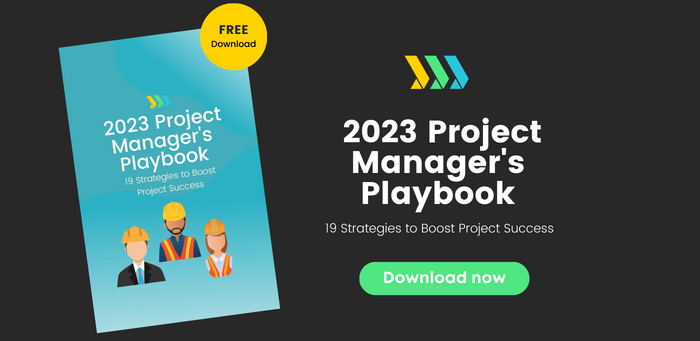Projects going over time and budget has become the norm in construction. So common that it’s become the subject of jokes. But shrinking margins are no laughing matter.
Currently, 92% of megaprojects come in over budget, over schedule, or both. A McKinsey analysis adds to this: “Large projects across asset classes typically take 20% longer to finish than scheduled and are up to 80% over budget.”
The truth is, despite it being the norm, such realities can be avoided.
After years of working with some of the biggest construction contractors, we’ve learnt some of the biggest causes of project overruns. In this article, we share that knowledge as well as the strategy you can follow to keep your projects running on time and within budget.
Reasons for projects running over time and budget
Schedule and budget culprits
Before we discuss the ‘how-to’, let’s first explore some of the main causes for projects running over in the first place. Below are five persistent culprits that we often come across from our customers…
Fragmentation in the planning process
In construction, we’ve got the planning phase down, but the same cannot be said for the construction execution phase.
There’s a disconnect between the part where the architect and engineer make plans and the part when the building actually gets built.
The planners have an idea of how it all fits together, but the different contractors and subcontractors don’t always share this bird’s-eye view. Likewise, it’s difficult for planners to anticipate the real-life issues that can come up on the jobsite.
The result? It slows the project's progress and leads to more errors.
Miscommunications between trades
The lack of a management system that ties everything together in the execution phase leads to trades not communicating when, in reality, their work is interconnected. The industry has become notorious for everyone staying in their own silos.
If one subcontractor doesn’t know that the subcontractor upon whose work he was dependent has been finished for two days, that’s two days wasted in the overall schedule. On the other hand, if there’s a delay in the previous sub signing off, and the next sub has already arrived and has to wait around, that’s money wasted.
Inefficient processes
While the planners understand well how the trades fit into the three dimensions of the structure, the fourth dimension might be missing: the timeline. If it’s not clear how all those pieces converge and are contingent upon one another, we fall into the trap of inefficient processes. And then our firm feels the effect on their profits.
Unforeseen external circumstances
One external circumstance on everyone’s mind right now is the increase in the price of materials. But over the course of history we know such problems can arise, although we can’t predict exactly what they will be–the “known unknowns”, to quote former US Secretary of Defense Donald Rumsfield.
Wrong estimation
At the outset, we’re often too optimistic and ambitious in our project estimates. Daniel Kahneman, Nobel prize winner in Economics, cautions:
"When forecasting outcomes of risky projects, executives too easily fall victim to the ‘planning fallacy’. In its grip, they make decisions based on delusional optimism rather than on a rational weighing of gains, losses, and probabilities. They overestimate benefits and underestimate costs." (Kahneman, 2012, 252)
3 steps: staying on time and under budget:
You may have come across many tips and tricks for delivering construction projects on schedule and within budget. These tips usually focus on changing behaviour to offset a particular hurdle, but generally, this is a reactive way of working.
The truth is, there’s a better way to tackle this issue. To make lasting change on your projects and as an industry as a whole, we have to resolve the problem from the root - not just prune the tree. In other words, we have to change our mindset as an industry.
We’ve found that there are three steps you can take to offset poor project performance no matter what the cause:
STEP 1: Shift the focus from planning to execution
STEP 2: Focus on data vs. estimations
STEP 3: Turn to production-based systems
1. Shift the focus from planning to execution.
Planning and topics like BIM are useful and have been in the focus for so long, the issue is that they don’t get to the heart of where many of the inefficiencies in construction lie: the construction execution phase.
- The construction execution phase is the phase of the project that is most vulnerable to errors.
- It’s the phase where much of the fragmentation within the industry shows up in the form of miscommunication and silos.
- It’s the phase where many of the inefficiencies within the construction ways of working are brought to light.
A report by McKinsey found that improving the on-site execution phase would be a key driver in boosting productivity in the industry. This is a trend that the industry is starting to notice with increased investment into technology focused on the construction execution phase.
The fundamental shift you need to make to deliver your projects on time and within budget is to shift the focus from planning to optimising the thousands of on-site tasks and activities that make up the final project.
This is the foundation that the other two steps are based on so this is crucial to establish in the way you prioritise your time and your focus.
2. Move from relying on rough estimations to data.
The accuracy of project estimations has not improved much since the 1970s, as data science and project management thought leader Yael Grushka-Cockayne points out.
Typically planners make plans based on estimates that are founded on their previous knowledge and experience. This leads to massive inaccuracies when it comes to the actual execution of the project.
The main problem is not paying attention to information based on a wide set of data from similar projects. We have to move from planning based on estimates to planning based on actual previous project data. Otherwise, there’s no surprise that projects run over time and budget if they are only founded on the planner’s internal reasoning.
There is a shift happening where we look at what is actually happening on the project (the execution)- asking people working on the ground, using historical data from previous projects to learn from this and improve estimations and decisions going forward.
But don’t just take our word for it.
Project management and planning expert at Oxford University Bent Flyvbjerg advises planners to use all data available to be able to make a more accurate forecast. The wider we can make our baseline for predictions, the more time and money “culprits” we can account for. And Grushka-Cockayne maintains that “accuracy estimates can be established” by using historical data.
Using rich historical data to plan the execution of your projects more effectively is the key.
3. Turn to production-based systems.
So we know how important the execution phase backed by data is. Now, this is where the work you do in the background will really come to life.
Taking a production-based approach to the execution of a project will help you to smooth out the inefficiencies and fragmented ways of working that lead to delays and mistakes.
McKinsey has even stated that one of the key ways to introduce a radical shift in the industry’s productivity is to introduce manufacturing-inspired mass-production systems.
Think about the results and the final project you need to deliver, and break down the project into individual deliverables to help you deliver each part seamlessly. Look at the execution plan for each of the deliverables.
A great movie script can’t turn itself into a box-office success without a production department making sure all components are being carried out according to schedule.
To summarise: The simple way to deliver projects on time and within budget
To summarise, the steps to delivering projects on time and within budget should look something like this:
STEP 1: Shift the focus from planning to execution
STEP 2: Plan projects based on real historical data
STEP 3: Turn to production-based systems to streamline project delivery
We’ve developed Sablono over the years to meet our customer’s deep desire to make their projects more efficient, and we’ve created a solution that helps customers make the shifts above in a simple and straightforward way.
Sablono is a construction execution software solution that connects your entire construction supply chain and turns your project into a production plan.
When you use a production-based system like Sablono, you can get to the bottom-up reality of what it will take to get the project done, instead of an “all information filters from the top-down”, planner-driven approach.
Sablono helps you manage your deliverables
Key features: Trade to Trade Handovers, Real-Time Status Reporting, Visual Trackers
With Sablono, you can manage all the different elements that make up your project at a granular level of detail.
One of the benefits of our software is the ability to toggle between the helicopter view of how everything fits together, down to the “screwdriver work'' of each sub’s deliverable. Sablono facilitates the flow of communication in all directions. (You can see more about how Sablono helps improve communication in our previous article.)
Have trades easily report the status of their activities in the Sablono app and automatically notify trades when work is ready for them to complete.
Transparent status reporting gives you an accurate real-time view of your project so you have a clear view of everything that is happening on your project right down to the individual level.
Sablono takes all of the different elements of your project and puts them into one place. Replace spreadsheets and multiple trackers with a centralised, connected system. Convert your project drawings into automated visual trackers so you can easily understand what’s been done and what’s not been done, and access real-time progress and quality data.
Sablono helps you make data-based decisions
Key features: Duration Estimation, Root Cause Analysis
Sablono gives you access to tangible historical data from your previous projects. You can tap into features like ‘duration estimation’ to understand how long a project should take based on previous data.
This previous data can even help you to understand the root cause of defects, quality issues and hold-ups so that you can prevent them from happening again.
Replacing theory with on-the-ground facts for greater accuracy, Sablono helps you to make truly data-driven decisions.
Sablono helps you to move to production-based workflows
Key features: Standardised Sequences
Scale your work quickly by turning your construction project into a production plan. Use your existing data to identify best-practice techniques, then create standardised sequences based on these results to define the flow of trades, quality checks, workflows and more.
This allows you to rinse and repeat your success to boost your production and significantly reduce errors and reworks.
Sablono helps you to get it right first time
Key features: Look-Ahead Planning, Semi-automated Workflows
Streamline your processes with semi-automated workflows and create a look-ahead plan that helps you to see if you’re really on track to delivering your project on time and within budget.
With Sablono your entire execution plan is connected so you dynamically see how changes to one part of your project will affect all the other parts. This helps you to plan with confidence and proactively prevent issues.
Want to learn how Sablono can help you deliver your construction project on time and within budget? Get a demo today.




